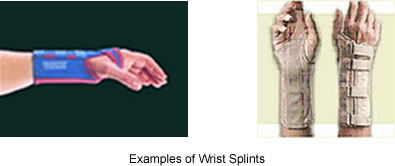
(888) 782-8338

ErgoMatters℠ is moving to SafeAtWorkCA.com, State Fund’s safety resource center. Click the link below to find all of our ErgoMatters content. ErgoMatters on SafeAtWorkCA.com |
What are wrist splints?Wrist splints are immobilization devices used to keep the wrist straight and help heal from injury.

Why are they used? Wrist splints can provide pain relief and rest, typically on people with possible symptoms of carpal tunnel syndrome. These devices are especially effective off-the-job, particularly during sleep and should be prescribed by a treating physician.
Should an employer give them to employees? Why or why not? Wrist splints should not be given by an employer to relieve pain or prevent the development of work-related musculoskeletal disorders. Wrist splints are medical devices and a treating physician, who has knowledge of the benefits and possible negatives of these devices, should be the only one dispensing these devices to individuals. Employees who struggle to perform a wrist-bending task, with a splint designed to prevent wrist bending, can exacerbate symptoms because of the increased force needed to overcome the splint. Limiting wrist bending in a job that requires wrist bending can also cause pressure points (similar to that of a tight shoe), tendonitis above or below the wrist, and other detrimental effects at the shoulder (Mell, Childress, Hughes, 2005), neck, and elbow. It can also affect the way a person works mentally because subconsciously they may work differently (harder or in awkward positions) to off-set using the wrist splint. The bottom line is wrist splints should not be provided by the employer and if prescribed by a treating physician to be worn at work, be monitored carefully by that prescribing physician to prevent complications such as muscle atrophy or stress to another joint to compensate for the inability to move the wrist thru a full range of motion. First and foremost, the job or task should be evaluated to identify what is causing the problem and controls implemented.
Revised: 04/2017